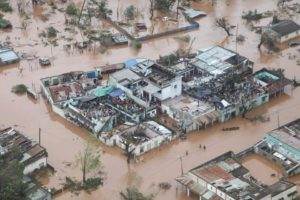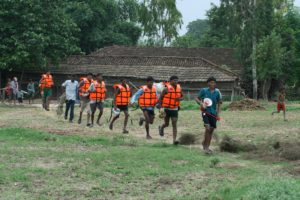March 15 marked the first anniversary of Cyclone Idai’s devastating charge through Zimbabwe, Malawi, and Mozambique (which was hit again a month later by Cyclone Kenneth, the strongest cyclone to ever hit the country). Cyclone Idai, which brought with it devastating winds, floods and landslides, was the world’s largest humanitarian disaster in 2019. More than 1,350 people lost their lives and over 3 million were affected, many of whom are still feeling the effects a whole year later.

Cyclone Idai devastated areas of Zimbabwe, Malawi and Mozambique
Learning from the past to build a more resilient future
We need to build resilience against changing natural hazards as the climate crisis means facing a new reality where extreme weather is becoming more common, and less predictable. In order to build such resilience we must learn from past events, figure out what went well and what needs to be done differently in the future. Together with Zurich Flood Resilience Alliance partners ISET-International and Zurich Insurance Group, we have applied the award winning Post Event Review Capability (PERC) methodology to learn from the impact of Idai in Malawi and Zimbabwe.
Beyond humanitarian response
Alleviating suffering in the direct aftermath of a disaster is critical, and through the Zurich Flood Resilience Alliance we partner with humanitarian organisations who do invaluable work responding to disasters. However, failing to follow-up such efforts by embedding disaster risk reduction (DRR) and climate adaptation solutions into long-term development planning means extreme weather events will continue to result in human suffering and undermine development goals.
Investing in DRR not only saves lives and reduces suffering, it is also cost effective. For every dollar invested in prevention and resilience building you save 5 in future losses.
Preparing for disasters in a new climate reality
Our PERC study showed that while a lot was done well in the aftermath of these events, there were some gaps in coordination, community awareness, connection with government, early warning, preparedness, and response structures. Particularly in places where this kind of extreme events haven’t been experienced before.
In Malawi where the memory of the deadly 2015 floods was still fresh, fewer people lost their lives this time, despite the floods being more severe than in 2015. On the other hand, in Zimbabwe’s Chimanimani and Chipinge districts where rainfall at the level brought by Idai has never been experienced before flooding and landslides caused widespread destruction and loss of life.
It is hardly surprising that people who regularly face natural hazards learn to deal with them and that investments are focused to protect communities that are seen as vulnerable. However, climate means that more of us who are not used to, and prepared for them, will face extreme events. Unless we’re proactive in building resilience to these changing risks we can expect worse disasters; more lives and livelihoods lost, and development successes undermined.
Early Warnings Systems that work
The experience from Malawi, where preparedness has been strengthened following previous events, enforces what we at Practical Action know, that Early Warning Systems (EWS) save lives and livelihoods. Still, improvements to flood forecasting, user-centered and contextualised early warning messages, safe evacuation routes, and safe shelters are needed to make early warning more successful.
Through the Zurich Flood Resilience Alliance Practical Action has experience of working together with communities in Nepal, Bangladesh, and Peru to build strong, community based and owned Early Warning Systems. The knowledge we have gained from this work can be used to inform similar efforts in Malawi and Zimbabwe.

Mock emergency drills, like this one in Nepal, are one of the ways we help communities become more resilient to floods
Resilience that protects
Climate change doesn’t only magnify the need for Disaster Risk Reduction in the face of increasing extreme weather events. We also need to learn to deal with more gradual, but no less devastating, stresses such as lack of rainfall and changing farming conditions to make sure that those hardest hit by the climate crisis have the tools to adapt and thrive despite these challenges.
To achieve this development planning must be solidly grounded in forward-looking systems thinking. All our work must address current needs while also reducing underlying vulnerabilities and planning for future change. Projects that deliver risk reduction and adaptation co-benefits such as ecosystem restoration should become the norm.
You can visit the Flood Resilience Portal to find out more about the Post Event Review Capability and read the executive summary of PERC Idai, as well as specific recommendations for Early Warning Systems and Climate Information Services in Zimbabwe and Malawi. The full PERC report will be available on April 25.